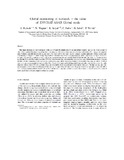Global monitoring of wetlands - the value of ENVISAT ASAR Global mode
Date
2008-03-17Author
Bartsch, A.
Wagner, W.
Scipal, K.
Sabel, D.
Wolski, P.
Publisher
ElsevierType
Published ArticleMetadata
Show full item recordAbstract
This paper elaborates on recent advances in the use of ScanSAR technologies for wetland-related research. Applications of active satellite radar systems include the monitoring of inundation dynamics as well as time series analyses of surface soil wetness. For management purposes many wetlands, especially those in dry regions, need to be monitored for short and long-term changes. Another application of these technologies is monitoring the impact of climate change in permafrost transition zones where peatlands form one of the major land cover types. Therefore, examples from boreal and subtropical environments are presented using the analysed ENVISAT ASAR Global mode (GM, 1 km resolution) data acquired in 2005 and 2006. In the case of the ENVISAT ASAR instrument, data availability of the rather coarse Global Mode depends on request priorities of other competing modes, but acquisition frequency may still be on average fortnightly to monthly depending on latitude. Peatland types covering varying permafrost regimes of the West Siberian Lowlands can be distinguished from each other and other land cover by multitemporal analyses. Up to 75% of oligotrophic bogs can be identified in the seasonal permafrost zone in both years. The high seasonal and interannual dynamics of the subtropic Okavango Delta can also be captured by GM time series. Response to increased precipitation in 2006 differsfrom flood propagation patterns. In addition, relative soil moisture maps may provide a valuable data source in order to account for external hydrological factors of such complex wetland ecosystems.
Collections
- Research articles (ORI) [270]

